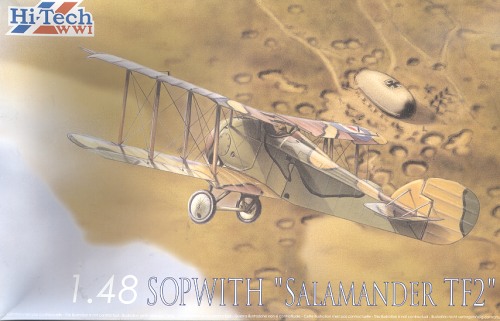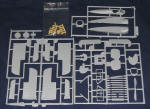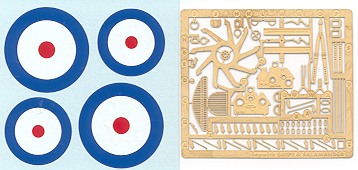
| KIT: | Hi-Tech 1/48 Sopwith Salamander TF2 |
| KIT #: | HT 017 |
| PRICE: | $49.96 MSRP ($44.96 at Squadron) |
| DECALS: | One option |
| REVIEWER: | Scott Van Aken |
| NOTES: | Short run with resin and photo-etch parts |

| HISTORY |
The Sopwith T.F.2 Salamander (T.F. stood for Trench Fighter or what we now call a ground attack fighter) owed much to the Snipe fighter, but its entire forward fuselage was new. It was an armoured box with an 11 mm bottom plate and 6 mm side plates. The rear end consisted of 10 mm and 6 mm plates spaced 95 mm apart, and an armoured headrest was fitted. The front plate was only 8 mm thick, because the mass of the engine was reckoned to provide additional protection for the pilot. The Salamander was an early example of the use of “structural armour”, that is, instead of being bolted on, the armour was designed as a part of the aircraft's main structure, carrying loads as well as protecting the occupant. For decades such structures remained quite difficult to manufacture with sufficient precision. The implication for the Salamander was that the attachment points for the lower wing spars were not correctly aligned, because the hardening process distorted the elements of the armoured box to which they were directly attached. The upper wing, which was carried on struts, could be correctly rigged.
An air-cooled engine was preferred to a liquid-cooled type. The 230 hp Bentley B.R.2 had reached the limit of what could be achieved with rotary engines, but the air-cooled engine was less vulnerable to damage, and its greater frontal area offered more protection to the pilot. The fuel system was redesigned to include an emergency hand-pump, installed on the inside of the armoured box. The designers also sought to make the rest of the structure more damage resistant. The tailplane had a metal instead of a wooden main spar, and later the bracing wires for the tailplane were replaced by steel tubes.
Initially two downward-firing Lewis guns (at an angle adjustable between 35 and 55 degrees) and a single gun firing forward were planned, but as mentioned above, the pilots preferred two forward-firing Vickers guns, and this armament was installed. On production aircraft the guns were staggered, so that ammunition boxes for 1000 rpg could be accommodated. Empty cases were dumped overboard. The aircraft could also carry four 20-lb bombs, but such bombs were a standard fitting for RAF fighters for a long period. The Salamander was not well received by pilots, indeed it was described by one officer as “clumsy” and “more lethal to its pilot than to the enemy.” Inevitably the T.F.2 was much heavier than a Snipe, with an empty weight of 835 kg against 592 kg, but it did not have more engine power. The rate of climb at 3050 m was only half that of a Snipe. The problems in rigging the lower wing must have contributed to the unsatisfactory handling characteristics. The Salamander picked up speed quickly in a dive, and landed at a fairly high speed for the period. Over 400 were built, most of them after WWI, but they were never assigned to an operational unit.
| THE KIT |
 Upon
opening the box, I found three sprues of injected plastic, with nicely done
rib webbing detail. The surface of the plastic is a tad rough, but nothing
major. All the parts have some level of flash, but it is to be expected and
none of it is major. Thankfully, there were no sink areas, even though some
of the plastic is relatively thick. All of the flight surfaces are a single
piece, which is a logical choice for aircraft from this era. An alternate
set of upper ailerons is also provided. I found all the parts floating
around in the box, but though some parts had partially broken free, non
were damaged.
Upon
opening the box, I found three sprues of injected plastic, with nicely done
rib webbing detail. The surface of the plastic is a tad rough, but nothing
major. All the parts have some level of flash, but it is to be expected and
none of it is major. Thankfully, there were no sink areas, even though some
of the plastic is relatively thick. All of the flight surfaces are a single
piece, which is a logical choice for aircraft from this era. An alternate
set of upper ailerons is also provided. I found all the parts floating
around in the box, but though some parts had partially broken free, non
were damaged.
There is a small bag with resin parts
for the engine, which consists of a crankcase and nine separate cylinders,
as well as two machine guns. These are all well done with no signs of
molding flaws. Also included is a photo-etch fret that includes the detail
parts. These comprise things like the seat, rudder pedals, control grip,
hinges, instrument panel, floor, gun sights and a number of other bits.
This set is also designed for the Snipe so one has to be sure to use the
right parts. They are all numbered. The builder will have to stretch some
sprue for things like the control stick, engine pushrods and seat support.
The kit instructions are a single sheet of paper folded in half. On the main page is a list of references and an explanation as to why the kit is the way it is (i.e. not for beginners). The inside has an exploded view of the kit parts, and a detail drawing of engine push rod application (along with an explanation that you may have to shave the top of some cylinders to get the engine to fit in the cowling). On the back is a three view drawing showing the camouflage of a single example from July 1918. The decals provided are four roundels, and I have to say that I think the proportions are off as it seems to have too much white. I'd get some aftermarket or paint them on.
| CONCLUSIONS |
Overall, this seems like a pretty straight-forward short run kit. Those who have done a few of these will not find anything really different or difficult about this one and it will add yet another interesting WWI aircraft to the builder's collection.
You can find this kit and many others at

If you would like your product reviewed fairly and fairly quickly by a site that has around 300,000 visitors a month, please contact me or see other details in the Note to Contributors.